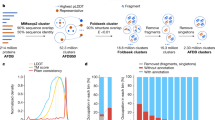Abstract
As more and more proteins are sequenced, the search for sequential and structural interrelationships among them is becoming a major activity, even though it is still in its infancy compared with investigations dealing with ancestral relationships1,2. For our study of homologous regions found among ancestrally unrelated proteins we have modified McLachlan's double matching method3 and used it to find the statistically significant homologies. The method, the details of which are being published elsewhere4, enables a computer to perform a sliding match between two proteins, either when both proteins are aligned from N-terminal to C-terminal, which we call ‘normal matching’, or when one is aligned from N-terminal to C-terminal while the other is aligned from C-terminal to N-terminal, which we call ‘reverse matching’. At each step during this sliding match, some amino acids will be found to be identical between the two proteins being matched and some others will be different. Based on similarities found among ancestrally related proteins the probability of each amino acid being substituted by another is calculated—the M score of similarity3—and printed. The scores reach from 0, a non-match, all the way to 8 and 9 both of which stand for exact matches, 9 being assigned to phenylalanine, cysteine, tyro-sine and tryptophan. For ease of detection, the printout has a stop (˙) for a score of 8 and a prime (′) for a score of 9 (ref. 4). The same molecule can also be matched against itself to reveal the presence of repeating subsequences and symmetry patterns5.
This is a preview of subscription content, access via your institution
Access options
Subscribe to this journal
Receive 51 print issues and online access
$199.00 per year
only $3.90 per issue
Buy this article
- Purchase on Springer Link
- Instant access to full article PDF
Prices may be subject to local taxes which are calculated during checkout
Similar content being viewed by others
References
Dayhoff, M. O., Atlas of Protein Sequence and Structure, 5, (1972).
Fitch, W. M., J. molec. Biol., 49, 1 (1970).
McLachlan, A. D., J. molec Biol., 61, 409 (1971).
Greller, L. D., and Erhan, S., Int. J. Pept. Prot. Res., (in the press).
Erhan, S., and Greller, L. D., Int. J. Pept. Prot. Res. (in the press).
Sorm, F., and Keil, B., in Advances in Protein Chemistry, 167, 17 (Academic Press, New York, 1962).
Campbell, J. H., Lengyel, J. A., and Landridge, J., Proc. natn. Acad. Sci. U.S.A., 70, 1841 (1973).
Author information
Authors and Affiliations
Rights and permissions
About this article
Cite this article
ERHAN, S., GRELLER, L. Do immunoglobulins have proteolytic activity?. Nature 251, 353–355 (1974). https://doi.org/10.1038/251353a0
Received:
Revised:
Issue Date:
DOI: https://doi.org/10.1038/251353a0
This article is cited by
-
Antibodies as defensive enzymes
Springer Seminars in Immunopathology (2005)
-
Natural catalytic antibodies
Molecular Biotechnology (1996)
-
Catalytic activity of anti-ground state antibodies, antibody subunits, and human autoantibodies
Applied Biochemistry and Biotechnology (1994)
-
Immune recognition, antigen design, and catalytic antibody production
Applied Biochemistry and Biotechnology (1994)
-
Life cycle patterns and their genetic control: An attempt to reconcile evolutionary and mechanistic speculation
Acta Biotheoretica (1976)
Comments
By submitting a comment you agree to abide by our Terms and Community Guidelines. If you find something abusive or that does not comply with our terms or guidelines please flag it as inappropriate.



